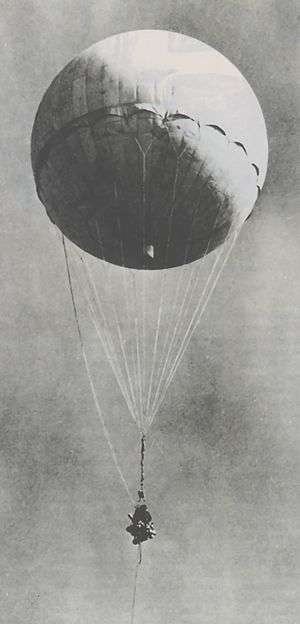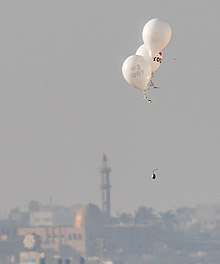Incendiary balloon
An incendiary balloon (or balloon bomb) is a balloon inflated with a lighter than air gas such as hot air, hydrogen, or helium, that has a bomb, incendiary device, or Molotov cocktail attached. The balloon is carried by the prevailing winds to the target area, where it falls or releases its payload.

Historical use
Early proposals

In 1792, Joseph-Michel Montgolfier proposed using balloons to drop bombs on British forces and ships in Toulon.[1]
In 1807, Denmark attempted to construct a hand-propelled dirigible that would bomb British ships blockading Copenhagen from the air.[2]
In 1846 a British board rejected as impractical a bombing design by Samuel Alfred Warner.[3] Attempts by Henry Tracey Coxwell to interest the British government a few years later were rejected as well.[3]
In 1847, John Wise proposed the use of balloon bombs in the Mexican–American War.[1]
Austrian use at Venice in 1849
The first aggressive use of balloons in warfare took place in 1849.[4][5] Austrian imperial forces besieging Venice attempted to float some 200 paper hot air balloons, each carrying a 24-to-30-pound (11 to 14 kg) bomb that was to be dropped from the balloon with a time fuse over the besieged city. The balloons were launched mainly from land; however, some were also launched from the side-wheel steamer SMS Vulcano that acted as a balloon carrier. The Austrians used smaller pilot balloons to determine the correct fuse settings. At least one bomb fell in the city; however, due to the wind changing after launch, most of the balloons missed their target, and some drifted back over Austrian lines and the launching ship Vulcano.[2][3][6]
World War II

Operation Outward
During World War II, the British Operation Outward launched some 99,142 balloons at Germany, 53,543 of which were carrying incendiaries the other 45,599 carrying trailing wires to damage high voltage lines.[7]
Fu-Go
In 1944–1945, during World War II, Japan launched some 9,300 Fu-Go balloon bombs at North America. The 10-meter (33 ft) diameter balloons were inflated with hydrogen and typically carried one 15 kilograms (33 lb) bomb, or one 12 kilograms (26 lb) bomb along with four 5 kilograms (11 lb) bombs.[8] The Fu-Go utilized the 220 miles per hour (350 km/h) winter jet stream to cross 5,000 miles (8,000 km) of the Pacific Ocean in approximately three days. To control altitude, the balloon used a barometric sensor that would release ballast sand-bags when the balloon went below 30,000 feet (9,100 m). When the sensor registered an altitude of above 38,000 feet (12,000 m), hydrogen was vented from the balloon. The whole mechanism was activated 52 minutes after launch to allow the balloon to reach initial altitude. The final sandbag stations were fitted with incendiary bombs which were released by the same mechanism, and after the last release the balloon activated a self-destruct mechanism and released an additional bomb.[9]
The balloons were launched in the winter to take advantage of the more favorable winter jet stream. However this limited their damage potential as wildfires were less likely to catch in winter.[10][11] The Fu-Go balloons inflicted relatively little damage, save for one fatal incident in which a woman and five children were killed near Bly, Oregon after they approached a balloon that had landed at the subsequently named Mitchell Recreation Area.[6][12] The deaths of six civilians were the only fatalities caused by fire balloons on American soil during World War II.[13]
Cold War
United States
Following WWII, the United States developed the E77 balloon bomb based on the Fu-Go balloon. This balloon was intended to disperse an anti-crop agent; however, it was not used operationally.[14][15] The 1954–1955 WS-124A Flying Cloud program tested high-altitude balloons for delivery of weapons of mass destruction, but was found unfeasible in terms of accuracy.[16]
Current use
Gaza Strip use

Since the beginning of the 2018 Gaza border protests, Palestinians have been launching incendiary kites at Israel as a form of Agro-terrorism. Since the beginning of May 2018,[17] helium-filled incendiary balloons have been used alongside the kites.[18][19][20] Gazan balloons are devised from helium-filled party balloons or condoms that are strung together, with flaming rags, other incendiary devices, or explosives strung below.[21][22] The prevailing wind blowing in from the Mediterranean Sea, propels the balloons inland from Gaza into Israel.[23][24]
According to a report in Ynet, as of 10 July 2018, incendiary kites and balloons started 678 fires in Israel, burning 910 hectares (2,260 acres) of woodland, 610 hectares (1,500 acres) of agricultural crops, as well as open fields.[25] Some balloons landed in the Eshkol Regional Council[26] and the Sdot Negev Regional Council, and no one was injured.[27] One balloon cluster reached Beersheba, some 40 kilometres (25 mi) from the Gaza strip.[28][29]
See also
References
- Military Aircraft, Origins to 1918: An Illustrated History of Their Impact, Justin D. Murphy, page 161
- Military Aircraft, Origins to 1918: An Illustrated History of Their Impact, Justin D. Murphy, page 9–10
- Military Ballooning During the Early Civil War, The Johns Hopkins University Press, F. Stansbury Haydon, page 18–20
- Air Power in the Age of Total War, John Buckley
- The Future of Drone Use: Opportunities and Threats from Ethical and Legal Perspectives, Asser Press - Springer, chapter by Alan McKenna, page 355
- Mikesh, Robert C. "Japan's World War II balloon bomb attacks on North America." (1973).
- The Moby Dick Project: Reconnaissance Balloons Over Russia, Curtis Peebles, Smithsonian Institution Press, page 56
- Biological Warfare Against Crops, S. Whitby, Palgrave Macmillan, page 163
- Unmanned Systems of World Wars I and II, H. R. Everett & Michael Toscano, MIT, page 247
- Fu-go: The Curious History of Japan's Balloon Bomb Attack on America, Ross Coen, page 192
- Arakawa, H. "Basic principles of the balloon bomb." Papers in Meteorology and Geophysics 6.3–4 (1956): 239–243.
- Nine from Aberdeen, Jeffrey M. Leatherwood, Cambridge Scholars Publishing, page 292
- Attack of the Fire Balloons – Japan’s Intercontinental Weapon, Praise Ojo, War History Online, August 25, 2018
- Biological Warfare Against Crops, S. Whitby, Palgrave Macmillan, page 167
- [Whitby, Simon M. "The potential use of plant pathogens against crops." Microbes and infection 3.1 (2001): 73–80.
- Parsch, Andreas (21 March 2006). "WS-124A Flying Cloud". Directory of U.S. Military Rockets and Missiles, Appendix 4: Undesignated Vehicles. Designation-Systems. Retrieved 10 December 2017.
- Kite terror continues to strike Gaza border communities, 8 May 2018, Ynet.
- Beyond kites: 'Fire balloons'; increasingly used to set southern Israel ablaze, Times of Israel, 4 June 2018
- Israel announces Gaza sanctions in response to cross-border blazes, Reuters, 9 July 2018
- Gaza rocket barrage triggers Israeli air strikes, BBC, 20 June 2018
- Israel's military struggles to battle party balloons, Financial Times, Mehul Srivastava, 20 June 2018
- Flaming Condoms Are the Newest Threat to Southern Israel, Bloomberg, Alisa Odenheimer, 21 June 2018
- Condoms, kites, birthday balloons: 'Silly' Gaza weapons could lead to real war, Times of Israel, Judah Ari Gross, 20 June 2018
- Salah, Hana; Tarnopolsky, Noga (18 June 2018). "They're calling it the Kite War. How a simple plaything became a potent weapon in the Gaza Strip". Los Angeles Times.
- Tzuri, Matan (10 July 2018). "Kite, balloon terrorism continues scorching Israel's land". Ynet. Retrieved 12 February 2020.
- "'Suspicious' Gaza balloon lands on grounds of empty school". The Times of Israel. 17 July 2018. Retrieved 24 July 2018.
- "Flaming balloon from Gaza lands in preschool near children at play". The Times of Israel. 17 July 2018. Retrieved 24 July 2018.
- Police investigate if ‘suspicious balloon’ in Beersheba came from Gaza, Times of Israel 31 January 2018
- In first, incendiary balloon lands in Be'er Sheva, YNET, Ilana Curiel and Matan Tzuri, 30 July 2018